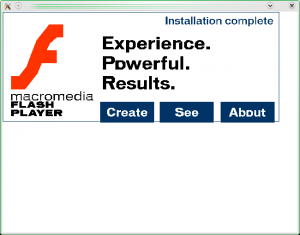Archive for March, 2009
The Lightspark Project, a modern flash player implementation
Posted by Alessandro Pignotti in Insane Projects on March 28, 2009
 When some months ago Adobe released the complete SWF file format specification I though that it would be nice to develop a well designed open source flash player. Now I’ve been working for some time on this idea and I’ve recently relased the code on SourceForge.
When some months ago Adobe released the complete SWF file format specification I though that it would be nice to develop a well designed open source flash player. Now I’ve been working for some time on this idea and I’ve recently relased the code on SourceForge.
The project objectives are quite ambitious, as the flash specification are really complex. The project is designed to take advance of the feautures present on modern hadrware, so it not supposed to run on older machines. All the graphic rendering is done using OpenGL and in the future programmable shaders will be used to offload even more calculations on the GPU. Extensive multithreading is employed to make use of multicore and hyper-threading processors. I’ll write a more detailed post about some tricky and interesting part of the project soon.
The Lightspark Project, a modern flash player implementation
Posted by Alessandro Pignotti in Insane Projects on March 28, 2009
 When some months ago Adobe released the complete SWF file format specification I though that it would be nice to develop a well designed open source flash player. Now I’ve been working for some time on this idea and I’ve recently relased the code on SourceForge.
When some months ago Adobe released the complete SWF file format specification I though that it would be nice to develop a well designed open source flash player. Now I’ve been working for some time on this idea and I’ve recently relased the code on SourceForge.
The project objectives are quite ambitious, as the flash specification are really complex. The project is designed to take advance of the feautures present on modern hadrware, so it not supposed to run on older machines. All the graphic rendering is done using OpenGL and in the future programmable shaders will be used to offload even more calculations on the GPU. Extensive multithreading is employed to make use of multicore and hyper-threading processors. I’ll write a more detailed post about some tricky and interesting part of the project soon.
A Nice Little Book of Semaphores
Posted by Jacopo Corbetta in Coding tricks on March 15, 2009
We’re currently busy working on assignments for the internal exams here at Sant’Anna School1 and we (well, Mirko) found a nice book for our parallel programming project. It’s “A Little Book of Semaphores”, freely available here.
It’s a very nice collection of concurrency problems, it deals with pretty much every one you could think of. So thank you professor Downey!
- Well, we’re also working on the usual stuff (ways to make big money, strange web 2.0 applications, high-performance-emulators, big robots, small robots, our many-times-acclaimed editor for Wikipedia, world domination, ...). [↩]
A Nice Little Book of Semaphores
Posted by Jacopo Corbetta in Coding tricks on March 15, 2009
We’re currently busy working on assignments for the internal exams here at Sant’Anna School1 and we (well, Mirko) found a nice book for our parallel programming project. It’s “A Little Book of Semaphores”, freely available here.
It’s a very nice collection of concurrency problems, it deals with pretty much every one you could think of. So thank you professor Downey!
- Well, we’re also working on the usual stuff (ways to make big money, strange web 2.0 applications, high-performance-emulators, big robots, small robots, our many-times-acclaimed editor for Wikipedia, world domination, ...). [↩]
A little VIM trick
Posted by Alessandro Pignotti in Sysadmin Kung Fu on March 2, 2009
This is a little useful trick for VIM users. As you may know VIM supports tabbed editing using the :tabnew command. It is then possible to switch between tabs using the :tabnext and :tabprev command. A faster shortcut is to add these two lines to the vimrc
nnoremap <F1> :tabprev
nnoremap <F2> :tabnext
Now you can use F1/F2 keys to switch between tabs.
A little VIM trick
Posted by Alessandro Pignotti in Sysadmin Kung Fu on March 2, 2009
This is a little useful trick for VIM users. As you may know VIM supports tabbed editing using the :tabnew command. It is then possible to switch between tabs using the :tabnext and :tabprev command. A faster shortcut is to add these two lines to the vimrc
nnoremap <F1> :tabprev
nnoremap <F2> :tabnext
Now you can use F1/F2 keys to switch between tabs.